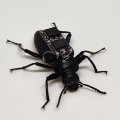University of Queensland researchers have helped identify a lipid (fat) inside cells which triggers a severe chain of events in some people.
The international collaboration involving researchers in Australia, Switzerland, and Japan discovered that the lipid, lysobisphosphatidic acid, was recognised by antibodies produced by some patients with a disorder known as antiphospholipid syndrome. The syndrome can cause miscarriage, thrombosis, and stroke in some cases.
Dr Parton, a senior researcher with the Centre for Microscopy and Microanalysis (CMM), the Centre for Molecular and Cellular Biology (CMCB) and the Physiology and Pharmacology Department, said that it was still unclear how many individuals were affected by this disorder but that antiphospholipid antibodies were detected in five percent of people suffering from veinous thrombosis, representing one in every 1000 people.
The syndrome is classed as an autoimmune disease because it involves the body essentially turning on itself. Antiphospholipid antibodies are also found in the bloodstream of patients suffering from infectious diseases such as malaria and AIDS.
'We all have this particular lipid in our cells, only for some unknown reason, some people's bodies raise antibodies against it,' he said.
Dr Parton was principal investigator of the Australian research group with laboratory work carried out together with postdoctoral research fellow Dr Espen Stang.
Their work pinpointed where the antigen or lipid was located in cells and explained why the resultant antibodies were harmful. This second discovery may lead to ways in which the effects of the antibodies can be blocked therefore preventing the disease's symptoms.
The two-year voyage of discovery is outlined in an article published in a recent edition of the renowned scientific journal Nature.
The project began in Professor Jean Gruenberg's laboratory at the University of Geneva as part of a three-year International Human Frontiers Science Foundation-funded project. His team raised antibodies against components of lysosomes.
Lysosomes effectively act as the cell's 'stomach', the membrane-enclosed acidic bag of enzymes processing proteins for use within the cell.
Dr Parton's research took this discovery a step further, using electron microscopy to identify the specific location of the target recognised by the antibodies.
Dr Toshi Kobayashi, a researcher with both the Japanese and Swiss group, then identified the specific lipid causing the reaction (lysobisphosphatidic acid). He tested people with antiphospholipid syndrome and discovered their bodies were raising antibodies against the same lipid.
'These antibodies were interfering with the cells' normal functioning and causing syndrome-associated health problems such as a high rate of miscarriage and thrombosis,' Dr Parton said.
His laboratory later used electron microscopy to examine how the produced antibodies were interfering with the normal traffic of proteins into and out of cells.
'Understanding this process may lead to ways of blocking the harmful effects of the antibodies at the cellular level therefore preventing the symptoms of antiphospholipid syndrome,' Dr Parton said.
Dr Parton joined the University as a joint appointment between the CMM, the Physiology and Pharmacology Department and the CMCB in February 1996, having spent eight years as a staff scientist at the renowned European Molecular Biology Laboratory (EMBL) in Germany.
He was recently recognised as being among the top five scientists publishing in the area of cell biology in Germany and Switzerland in 1995-96.
The assessment by German magazine Laborjournal was based on the number and quality of publications he had published in the field.
Dr Parton received the second largest new ARC large grant to the University in 1998.
He received $239,500 (with funding of $80,000 for 1998, $79,500 for 1999 and $80,000 for 2000) for a project examining the functional role of SNARE regulatory proteins in lysosomes.
This project will examine how the lysosome is made and how it works. The formation of the lysosome, a process controlled by a class of regulatory proteins termed SNARE proteins, is basically the same in humans, worms, or in baker's yeast showing the fundamental importance of the lysosome.
This project, which is a close collaboration between the laboratories of Dr Parton, Professor David James (CMCB, Physiology and Pharmacology Department) and Dr Rob Piper (University of Iowa) involves using genetic information from simple organisms such as yeast to build up a picture of the molecules involved in the formation and function of the lysosomes in higher organisms such as humans.
For more information, contact Dr Parton (telephone 07 3365 6468).
.jpg)

